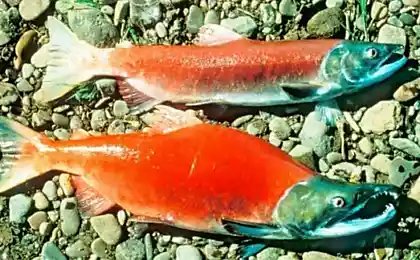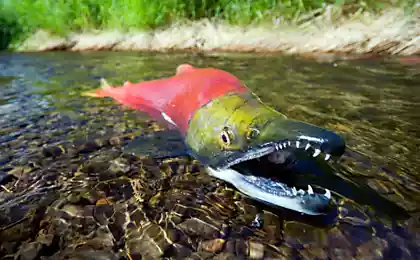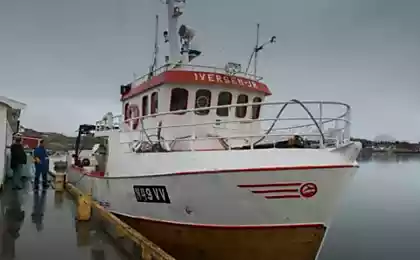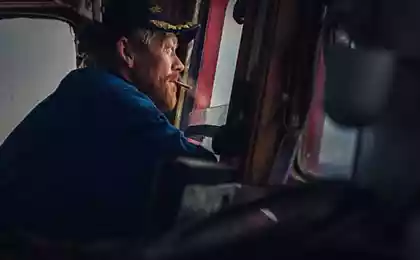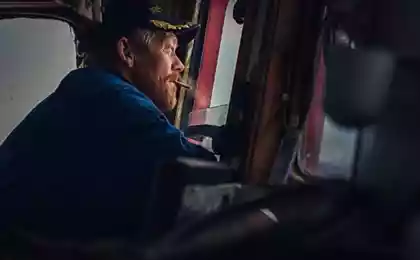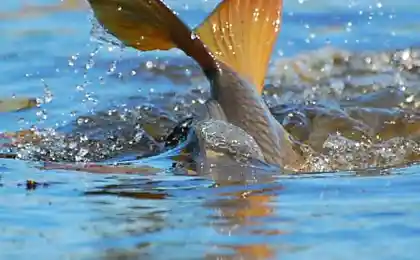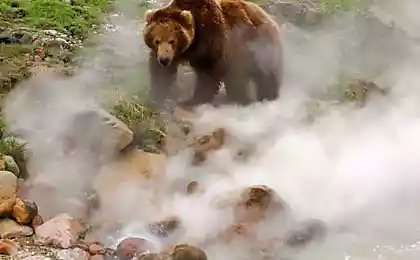1255
Spawning sockeye salmon
Sockeye salmon - salmon passage: is born and grows in fresh water, then rolls for feeding in the generous waters of the Pacific. Kuril Lake - vazhneyschy maternity hospital and a kindergarten. It has long been the Kurile Lake sockeye salmon has the highest number in Asia, only a few years behind Närke Kamchatka River - the largest river of the peninsula. Catch of the Kurile Lake sockeye from the beginning of the XXI century has increased significantly and now stands fifth of the total world catch of this species. The current due to the well-being of the population - is not entirely clear. Reduction in competition with other species of fish during feeding in the ocean? Warming of the planet, led to the improvement of conditions for sockeye?
Besides sockeye salmon in the basin of the lake live chinook, coho, pink salmon, chum salmon, nine-spined stickleback, three-spined stickleback, Arctic char and brown trout. But sockeye - a key part of the ecosystem of this area. She - a powerful biological fuel boiler lake. Herd Kurile Lake sockeye is now beautifully restored after overfishing of the last century, and the number of the mature part of the population is around 10 million individuals, sometimes from the sea back to twenty million individuals! The lake is passed to spawn 1, 5 - 2 million individuals, others are caught at the entrance to the river or the river. In addition, part of the total catch is extracted driftnets on the high seas. At the mouth of the river-headed, next to the gear for more than a hundred years, there is a fishing village Ozernovsky and production facilities for fish processing.
letters +6 Photo © Igor Shpilenok

First comes sockeye into the lake at the end of April, and the last - in February. Active spawning run begins in late May and ends in late October - early November. The massive entry of fish in the river uneven, it does have periods of recovery - "shocks" as they are called here, and fall. At the end of July-mid-August in the river comes to the greatest number of sockeye, this rune is called progress.
Modern technologies allow production to catch all the fish entering the river, so the organizers of the fishery established "communicating" the days when fishing is not conducted, and fish without hindrance rises. The distance from the mouth Ozernoi to the Kurile Lake sockeye overcomes for 3-4 days. At the entrance to the lake salmon pass through the fence at the hospital rybouchetnoe KamchatNIRO (Kamchatka Research Institute of Fisheries and Oceanography) know how many fish rose to spawn in the lake and its tributaries. Accounting for entering the lake sockeye conducted since 1940. Spawning try to skip from 1 to 2 million fish that is not always possible. In reality, the lake fall from 600 thousand to 6 million producers. When sockeye-jewel gets from the sea to fresh water, it stops feeding. Her body begins to rebuild, irreversible changes in appearance. The silver body turns bright red and his head - green. Before the spawning males begin to grow hook-like toothed jaw. Who came into the lake sockeye spawn in no hurry. First, it stands in dense clusters, each of which is concentrated tens of thousands of individuals. Fish stick closely to one another, and such clusters helicopter spots seem monolithic. Three-quarters of the area of spawning grounds are located in coastal shallows of the lake (Litoral) to a depth of 5 meters. On the river a quarter spawning areas.

Himself spawn in the lake basin starts in July and lasts until February usually. Old resident of the lake, and by far the most authoritative expert on him, the head of the hospital KamchatNIRO AV Maslov, observed spawning, even in March! At the same spawning grounds at different times spawn several shifts producers Observations ichthyologists from 4 to 6.
It has long been observed that fills Lake sockeye is not chaotic, and moves along the coast clockwise. First, there are concentrations of fish at the mouths of the First and Second Northern rivers Vychinkii then have Gavryushki and Kirushutki. In the last herds of sockeye coming to Hakytsynu and Etamynku. Sunset fish from the lake in a shallow river - a striking sight that I several years can be observed on the river Gavryusha. The width of its mouth just a meter and a half, and the depth on a sandy shoal - a few centimeters - can go without wetting his shoes. However, for a sandy beach surrounding the lake, the channel becomes deeper, appear omutki overhanging the coast, driftwood, stones - that is the place where the fish can hide from the bears. A few days thousands and thousands of fish congregate at the mouth Gavryushki. Fish walks along the lake shore, splashing, teasing the crowd on the beach hungry bears, which are almost in vain for her jump into the depths. Suddenly, as if by some signal crowd fish thrown into a narrow and shallow estuary, forming a wave. Val boiling water and fish can knock a person. The energy of this tree is that in a few minutes broadened and deepened, seemingly impassable for large fishes track. The first ten fish in shallow water are easy victims of bears, but while animals eat them, hundreds of fishes manage to slip through the sandy shallows to relatively deep water. And so repeats many times.

When spawning, the female digs a nest in the ground, the males often appear when the nest is ready, but sometimes also take part in its preparation. Male and female consistently produce eggs and milk in several series, buried pebbles deferred eggs - thus spawning the hill formed. The strongest male tries to not let the jack weaker, his genes are usually passed on to offspring. The female also drives away from the nest of small applicants for paternity. Sweeps the whole eggs and burying the nest, the female remains in place waiting for his death. Males for some time can continue their activity in search of new females with nests, but still doomed to die soon after spawning.
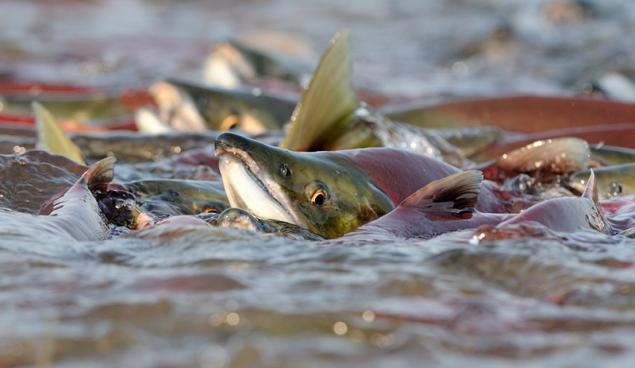
When sockeye salmon comes to spawn too many nests with eggs can be destroyed again approached producers. In addition, when excessive density spawning fish is stressed and can not normally spawn.
Development of sockeye salmon eggs before leaving the soil depends on many factors and lasts from 5 to 8 months.
Salmon herds operate like a huge conveyor by mutual sharing of resources between sea and land. The young sockeye, for example, was born in the upper reaches of the river and, after living in fresh water for two years (part of young lives in fresh water a year, or three years), sinking into the ocean, feeds and develops there from 2 to 4 years, while providing nutrition predatory fish, birds and humans. Then he raised salmon from the ocean back to the river, going against the current, overcoming the obstacles in the form of turbulent rapids, networks of fishermen and poachers, bear claws. Then spawn and imminent death near the nest with just delayed caviar. Nutrients brought in the bodies of the parents of the generous ocean, get to feed the fish fry. The huge biomass killed on spawning salmon gives parents a considerable amount of scarce materials to the poor northern ecosystems, fertilizing rivers, floodplain forests. The researchers found that one fourth of the nitrogen contained in the trees and other vegetation along the banks of rivers and lakes, is brought from the ocean. It turns out that came from the ocean salmon provide power not only to their offspring, not only to people and wild animals, and even trees and grass!
A few days ago in the waters of the Kurile Lake went on to spawn the first large herds of sockeye. We gathered here to bear over the long vegetarian diet.
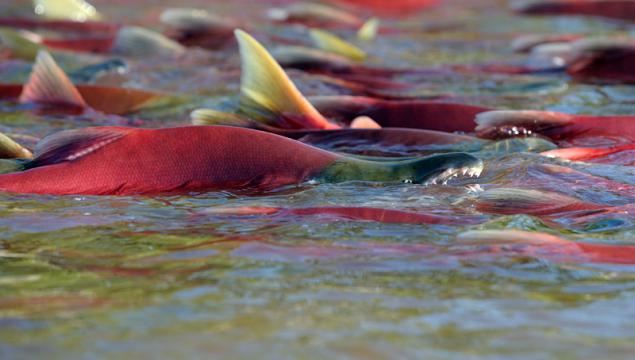
Lucky angler))
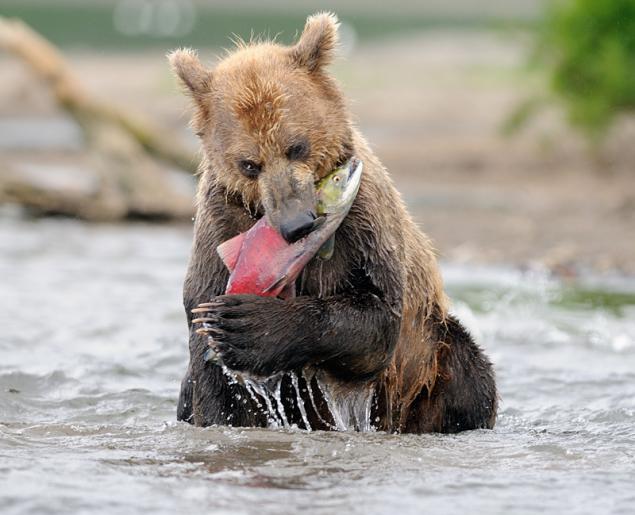
Source:
Besides sockeye salmon in the basin of the lake live chinook, coho, pink salmon, chum salmon, nine-spined stickleback, three-spined stickleback, Arctic char and brown trout. But sockeye - a key part of the ecosystem of this area. She - a powerful biological fuel boiler lake. Herd Kurile Lake sockeye is now beautifully restored after overfishing of the last century, and the number of the mature part of the population is around 10 million individuals, sometimes from the sea back to twenty million individuals! The lake is passed to spawn 1, 5 - 2 million individuals, others are caught at the entrance to the river or the river. In addition, part of the total catch is extracted driftnets on the high seas. At the mouth of the river-headed, next to the gear for more than a hundred years, there is a fishing village Ozernovsky and production facilities for fish processing.
letters +6 Photo © Igor Shpilenok

First comes sockeye into the lake at the end of April, and the last - in February. Active spawning run begins in late May and ends in late October - early November. The massive entry of fish in the river uneven, it does have periods of recovery - "shocks" as they are called here, and fall. At the end of July-mid-August in the river comes to the greatest number of sockeye, this rune is called progress.
Modern technologies allow production to catch all the fish entering the river, so the organizers of the fishery established "communicating" the days when fishing is not conducted, and fish without hindrance rises. The distance from the mouth Ozernoi to the Kurile Lake sockeye overcomes for 3-4 days. At the entrance to the lake salmon pass through the fence at the hospital rybouchetnoe KamchatNIRO (Kamchatka Research Institute of Fisheries and Oceanography) know how many fish rose to spawn in the lake and its tributaries. Accounting for entering the lake sockeye conducted since 1940. Spawning try to skip from 1 to 2 million fish that is not always possible. In reality, the lake fall from 600 thousand to 6 million producers. When sockeye-jewel gets from the sea to fresh water, it stops feeding. Her body begins to rebuild, irreversible changes in appearance. The silver body turns bright red and his head - green. Before the spawning males begin to grow hook-like toothed jaw. Who came into the lake sockeye spawn in no hurry. First, it stands in dense clusters, each of which is concentrated tens of thousands of individuals. Fish stick closely to one another, and such clusters helicopter spots seem monolithic. Three-quarters of the area of spawning grounds are located in coastal shallows of the lake (Litoral) to a depth of 5 meters. On the river a quarter spawning areas.

Himself spawn in the lake basin starts in July and lasts until February usually. Old resident of the lake, and by far the most authoritative expert on him, the head of the hospital KamchatNIRO AV Maslov, observed spawning, even in March! At the same spawning grounds at different times spawn several shifts producers Observations ichthyologists from 4 to 6.
It has long been observed that fills Lake sockeye is not chaotic, and moves along the coast clockwise. First, there are concentrations of fish at the mouths of the First and Second Northern rivers Vychinkii then have Gavryushki and Kirushutki. In the last herds of sockeye coming to Hakytsynu and Etamynku. Sunset fish from the lake in a shallow river - a striking sight that I several years can be observed on the river Gavryusha. The width of its mouth just a meter and a half, and the depth on a sandy shoal - a few centimeters - can go without wetting his shoes. However, for a sandy beach surrounding the lake, the channel becomes deeper, appear omutki overhanging the coast, driftwood, stones - that is the place where the fish can hide from the bears. A few days thousands and thousands of fish congregate at the mouth Gavryushki. Fish walks along the lake shore, splashing, teasing the crowd on the beach hungry bears, which are almost in vain for her jump into the depths. Suddenly, as if by some signal crowd fish thrown into a narrow and shallow estuary, forming a wave. Val boiling water and fish can knock a person. The energy of this tree is that in a few minutes broadened and deepened, seemingly impassable for large fishes track. The first ten fish in shallow water are easy victims of bears, but while animals eat them, hundreds of fishes manage to slip through the sandy shallows to relatively deep water. And so repeats many times.

When spawning, the female digs a nest in the ground, the males often appear when the nest is ready, but sometimes also take part in its preparation. Male and female consistently produce eggs and milk in several series, buried pebbles deferred eggs - thus spawning the hill formed. The strongest male tries to not let the jack weaker, his genes are usually passed on to offspring. The female also drives away from the nest of small applicants for paternity. Sweeps the whole eggs and burying the nest, the female remains in place waiting for his death. Males for some time can continue their activity in search of new females with nests, but still doomed to die soon after spawning.

When sockeye salmon comes to spawn too many nests with eggs can be destroyed again approached producers. In addition, when excessive density spawning fish is stressed and can not normally spawn.
Development of sockeye salmon eggs before leaving the soil depends on many factors and lasts from 5 to 8 months.
Salmon herds operate like a huge conveyor by mutual sharing of resources between sea and land. The young sockeye, for example, was born in the upper reaches of the river and, after living in fresh water for two years (part of young lives in fresh water a year, or three years), sinking into the ocean, feeds and develops there from 2 to 4 years, while providing nutrition predatory fish, birds and humans. Then he raised salmon from the ocean back to the river, going against the current, overcoming the obstacles in the form of turbulent rapids, networks of fishermen and poachers, bear claws. Then spawn and imminent death near the nest with just delayed caviar. Nutrients brought in the bodies of the parents of the generous ocean, get to feed the fish fry. The huge biomass killed on spawning salmon gives parents a considerable amount of scarce materials to the poor northern ecosystems, fertilizing rivers, floodplain forests. The researchers found that one fourth of the nitrogen contained in the trees and other vegetation along the banks of rivers and lakes, is brought from the ocean. It turns out that came from the ocean salmon provide power not only to their offspring, not only to people and wild animals, and even trees and grass!
A few days ago in the waters of the Kurile Lake went on to spawn the first large herds of sockeye. We gathered here to bear over the long vegetarian diet.

Lucky angler))

Source:
